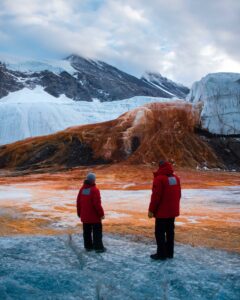In the heart of Antarctica’s stark and frozen expanse, where the McMurdo Dry Valleys stretch out in icy desolation, a startling and eerie phenomenon emerges from the Taylor Glacier. Known as Blood Falls, this vivid red cascade pours forth like a wound in the Earth’s icy surface, staining the pristine white landscape with its crimson hue.
The source of this strange and captivating spectacle lies deep within the glacier itself. The water, trapped for millennia in an ancient subglacial lake, is rich in iron and hypersaline. As it seeps to the surface and comes into contact with the air, a dramatic chemical reaction occurs. The iron oxidizes, much like rust forming on a piece of metal, resulting in the waterfall’s blood-red color.
This haunting scene is not only a visual marvel but also a scientific enigma. The inhospitable environment of the McMurdo Dry Valleys, one of the coldest and driest places on Earth, adds to the otherworldly feel of Blood Falls. Scientists are drawn to this remote location, intrigued by the possibility of uncovering clues about life in extreme conditions and the Earth’s past climate.
Blood Falls stands as a testament to the mysteries that our planet still holds. Its vivid red waters continue to flow, whispering secrets from the depths of time and ice, inviting us to delve deeper into the unknown.
